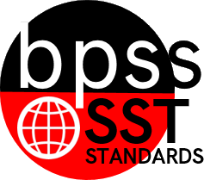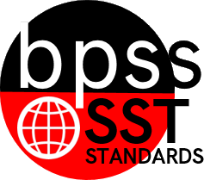SST-08.4.03
|
8th Grade SST Targeted Benchmarks
Standard 4: Political Systems
SST-08.4.03 Explain how the U.S. Constitution and Amendments influence society (e.g. voting rights, equal protection, due process).
|
Student Learning Targets:
Knowledge Targets
- I can identify the amendments in the Bill of Rights.
- I can recognize or recall specific terminology, such as:
- Constitution, Amendment, Preamble, Articles, Ratification, Democracy, Republic, Federal System
- Petition, Assemble, Quartering, Warrant, Probable Cause, Double Jeopardy, Due Process, Appeal, Right, Tranquility, Bail, Suffrage
Reasoning Targets
- I can demonstrate extended knowledge and understanding by independently and consistently connecting this standard to real world situations.
- I can analyze the goals of the Preamble (Why is each of the six goals important?).
- I can analyze current events, speeches, and/or scenarios and determine which rights apply.
|
| Rubric - Resources |
Student Learning Targets:
Knowledge Targets
- I can identify the amendments in the Bill of Rights.
- I can recognize or recall specific terminology, such as:
- Constitution, Amendment, Preamble, Articles, Ratification, Democracy, Republic, Federal System
- Petition, Assemble, Quartering, Warrant, Probable Cause, Double Jeopardy, Due Process, Appeal, Right, Tranquility, Bail, Suffrage
Reasoning Targets
- I can demonstrate extended knowledge and understanding by independently and consistently connecting this standard to real world situations.
- I can analyze the goals of the Preamble (Why is each of the six goals important?).
- I can analyze current events, speeches, and/or scenarios and determine which rights apply.
Proficiency Scale
| Score |
|
Description |
Sample Activity
|
| 4.0 |
In addition to Score 3.0, in-depth inferences and applications that go beyond what was taught.
The student:
- demonstrates extended knowledge and understanding independently and consistently by connecting to historical and/or current world situations.
|
- |
| |
3.5 |
In addition to Score 3.0 performance, the student demonstrates in-depth inferences and applications regarding the more complex content with partial success. |
| 3.0 |
The student can:
- identify the amendments in the Bill of Rights.
- analyze the goals of the Preamble (Why is each of the six goals important?)
- analyze current events, speeches, and/or scenarios and determine which rights apply.
|
- |
| |
2.5 |
The student demonstrates no major errors or omissions regarding the simpler details and processes (Score 2.0 content) and partial knowledge of the more complex ideas and processes (Score 3.0 content). |
| 2.0 |
There are no major errors or omissions regarding the simpler details and processes as the student:
- recognizes or recalls specific terminology, such as:
- Constitution, Amendment, Preamble, Articles, Ratification, Democracy, Republic, Federal System
- Petition, Assemble, Quartering, Warrant, Probable Cause, Double Jeopardy, Due Process, Appeal, Right, Tranquility, Bail, Suffrage
However, the student exhibits major errors or omissions regarding the more complex ideas and processes.
|
- |
| |
1.5 |
The student demonstrates partial knowledge of the simpler details and processes (Score 2.0 content) but exhibits major errors or omissions regarding the more complex ideas and procedures (Score 3.0 content). |
| 1.0 |
With help, the student demonstrates a partial understanding of some of the simpler details and processes (Score 2.0 content) and some of the more complex ideas and processes (Score 3.0 content). |
- |
| |
0.5 |
With help, the student demonstrates a partial understanding of some of the simpler details and processes (Score 2.0 content) but not the more complex ideas and processes (Score 3.0 content). |
| 0.0 |
Even with help, the student demonstrates no understanding or skill. |
- |
Resources
Websites
- Add resources with links, youtube or PDF
Vocabulary
|
 BPS District Social Studies Standards Book
BPS District Social Studies Standards Book

 Standard 4:
Standard 4: